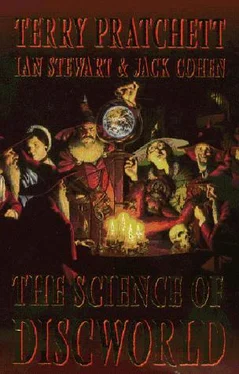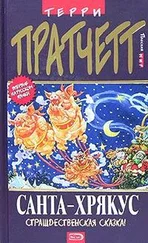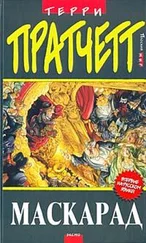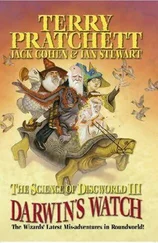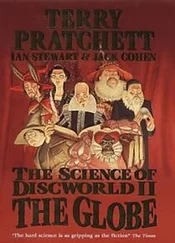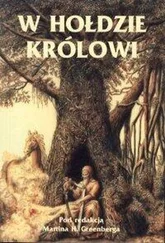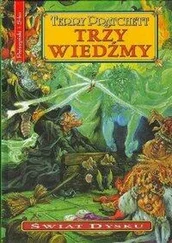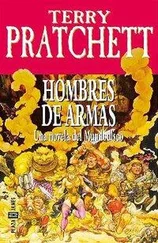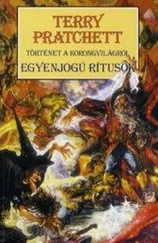Terry Pratchett - Science of Discworld
Здесь есть возможность читать онлайн «Terry Pratchett - Science of Discworld» весь текст электронной книги совершенно бесплатно (целиком полную версию без сокращений). В некоторых случаях можно слушать аудио, скачать через торрент в формате fb2 и присутствует краткое содержание. Жанр: Фантастика и фэнтези, на английском языке. Описание произведения, (предисловие) а так же отзывы посетителей доступны на портале библиотеки ЛибКат.
- Название:Science of Discworld
- Автор:
- Жанр:
- Год:неизвестен
- ISBN:нет данных
- Рейтинг книги:4 / 5. Голосов: 1
-
Избранное:Добавить в избранное
- Отзывы:
-
Ваша оценка:
- 80
- 1
- 2
- 3
- 4
- 5
Science of Discworld: краткое содержание, описание и аннотация
Предлагаем к чтению аннотацию, описание, краткое содержание или предисловие (зависит от того, что написал сам автор книги «Science of Discworld»). Если вы не нашли необходимую информацию о книге — напишите в комментариях, мы постараемся отыскать её.
Science of Discworld — читать онлайн бесплатно полную книгу (весь текст) целиком
Ниже представлен текст книги, разбитый по страницам. Система сохранения места последней прочитанной страницы, позволяет с удобством читать онлайн бесплатно книгу «Science of Discworld», без необходимости каждый раз заново искать на чём Вы остановились. Поставьте закладку, и сможете в любой момент перейти на страницу, на которой закончили чтение.
Интервал:
Закладка:
In 1934, following a lengthy series of discoveries in physics related to the phenomenon of radioactivity, Fermi discovered that interesting things happen when substances are bombarded with 'slow neutrons', subatomic particles emitted by radioactive beryllium, and passed through paraffin to slow them down. Slow neutrons, Fermi discovered, were just what you needed to persuade other elements to emit their own radioactive particles. That looked interesting, so he squirted streams of slow neutrons at everything he could think of, and eventually he tried the then obscure element uranium, up until then mostly used as a source of yellow pigment. By something apparently like alchemy, the uranium turned into something new when the slow neutrons cannoned into it, but Fermi couldn't work out what.
Four years later three Germans, Otto Hahn, Lise Meitner, and Fritz Strassmann, repeated Fermi's experiments, and being better chemists, they worked out what had happened to the uranium. Mysteriously, it had turned into barium, krypton, and a small quantity of other stuff. Meitner realized that this process of 'nuclear fission' produced energy, by a remarkable method. Everyone knew that chemistry could turn matter into other kinds of matter, but now some of the matter in uranium was being transformed into energy , something that nobody had seen before. It so happened that Albert Einstein had already predicted this possibility on theoretical grounds, with his famous formula, an equation which the orangutan Librarian of Unseen University would render as 'Ook'. Einstein's formula tells us that the amount of energy 'contained' in a given amount of matter is equal to the mass of that matter, multiplied by the speed of light and then multiplied by the speed of light again. As Einstein had immediately noticed, light is so fast it doesn't even appear to move, so its speed is decidedly big ... and the speed multiplied by itself is huge. In other words: you can get an awful lot of energy from a tiny bit of matter, if only you can find a way to do it. Now Meitner had worked out the trick.
A single equation may or may not halve your book sales, but it can change the world completely.
Hahn, Meitner and Strassmann published their discovery in the British scientific journal Nature in January 1939. Nine months later Britain was at war, a war which would be ended by a military application of their discovery. It is ironic that the greatest scientific secret of World War II was given away just before the war began, and it shows how unaware politicians then were of the potential -be it for good or bad, of Big Science. Fermi saw the implications of the Nature article immediately, and he called in another top-ranking physicist, Niels Bohr, who came up with a novel twist: the chain reaction. If a particular, rare form of uranium, called ura-nium-235, was bombarded with slow neutrons, then not only would it split into other elements and release energy, it would also release more neutrons. Which, in turn, would bombard more uranium-235 ... The reaction would become self-sustaining, and the potential release of energy would be gigantic.
Would it work? Could you get 'something for nothing' in this way? Finding out was never going to be easy, because uranium-235 is mixed up with ordinary uranium (uranium-238), and getting it out is like looking for a needle in a haystack when the needle is made of straw.
There were other worries too ... in particular, might the experiment be too successful, setting off a chain reaction that not only spread through the experiment's supply of uranium-235, but through everything else on Earth as well? Might the atmosphere catch fire? Calculations suggested: probably not. Besides, the big worry was that if the Allies didn't get nuclear fission working soon then the Germans would beat them to it. Given the choice between our blowing up the world and the enemy blowing up the world, it was obvious what to do.
That is, on reflection, not a happy sentence.
Loko is remarkably similar to Oklo in southeastern Gabon, where there are deposits of uranium. In the 1970s, French scientists unearthed evidence that some of that uranium had either been undergoing unusually intense nuclear reactions or was much, much older than the rest of the pknet.
It could have been an archaeological relic of some ancient civilization whose technology had got as far as atomic power, but a duller if more plausible expanation is that Oklo was a 'natural reactor'. For some accidental reason, that particular patch of uranium was richer than usual in uranium-235, and a spontaneous chain reaction ran for hundreds of thousands of years. Nature got there well ahead of Science, and without the squash court.
Unless, of course, it was an archaeological relic of some ancient civilization.
Until late in 1998, the natural reactor at Oklo was also the best evidence we could find to show that one of the biggest 'what if?' questions in science had an uninteresting answer. This question was 'What if the natural constants aren't?
Our scientific theories are underpinned by a variety of numbers, the 'fundamental constants'. Examples include the speed of light, Planck's constant (basic to quantum mechanics), the gravitational constant (basic to gravitational theory), the charge on an electron, and so on. AD of the accepted theories assume that these numbers have always been the same, right from the very first moment when the universe burst into being. Our calculations about that early universe rely on those numbers having been the same; if they used to be different, we don't know what numbers to put into the calculations. It's like trying to do your income tax when nobody will tell you the tax rates. From time to time maverick scientists advance the odd 'what if?' theory, in which they try out the possibility that one or more of the fundamental constants isn't. The physicist Lee Smolin has even come up with a theory of evolving universes, which bud off baby universes with different fundamental constants. According to this theory, our own universe is particularly good at producing such babies, and is also particularly suited to the development of life. The conjunction of these two features, he argues, is not accidental (the wizards at UU, incidentally, would be quite at home with ideas like this, in fact, sufficiently advanced physics is indistinguishable from magic).
Oklo tells us that the fundamental constants have not changed during the last two billion years, about half the age of the Earth and ten per cent of that of the universe. The key to the argument is a particular combination of fundamental constants, known as the 'fine structure constant'. Its value is very close to 1/137 (and a lot of ink was devoted to explanations of that whole number 137, at least until more accurate measurements put its value at 137.036). The advantage of the fine structure constant is that its value does not depend on the chosen units of measurement, unlike say, the speed of light, which gives a different number if you express it in miles per second or kilometres per second. The Russian physicist Alexander Shlyakhter analysed the different chemicals in the Oklo reactor's 'nuclear waste', and worked out what the value of the fine structure constant must have been two billion years ago when the reactor was running. The result was the same as today's value to within a few parts in ten million.
In late 1998, though, a team of astronomers led by John Webb made a very accurate study of the light emitted by extremely distant, but very bright, bodies called quasars. They found subtle changes in certain features of that light, called spectral lines, which are related to the vibrations of various types of atom. In effect, what they seem to have discovered is that many billion years ago, much further back than the Oklo reactor, atoms didn't vibrate at quite the same rate as they do today. In very old gas clouds from the early universe, the fine structure constant differs from today's value by one part in 50,000. That's a huge amount by the standards of this particular area of physics. As far as anyone can tell, this unexpected result is not due to experimental error. A theory suggested in 1994 by Thibault Damour and Alexander Polyakov does indicate a possible variation in the fine structure constant, but only one-ten thousandth as large as that found by Webb's team. It's all a bit of a puzzle, and most theorists sensibly prefer to hedge their bets and wait for further research. But it could be a straw in the wind: perhaps we will soon have to accept that the laws of physics were subtly different in the distant reaches of time and space. Not turtle-shaped, perhaps, but... different.
Читать дальшеИнтервал:
Закладка:
Похожие книги на «Science of Discworld»
Представляем Вашему вниманию похожие книги на «Science of Discworld» списком для выбора. Мы отобрали схожую по названию и смыслу литературу в надежде предоставить читателям больше вариантов отыскать новые, интересные, ещё непрочитанные произведения.
Обсуждение, отзывы о книге «Science of Discworld» и просто собственные мнения читателей. Оставьте ваши комментарии, напишите, что Вы думаете о произведении, его смысле или главных героях. Укажите что конкретно понравилось, а что нет, и почему Вы так считаете.
